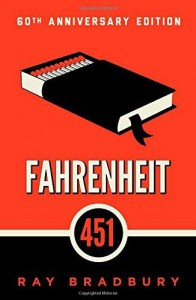A lot of crazy stuff going on in the 1950s. Television was a new thing, really. There were radios in every home, but most of the living rooms with TVs were located in New York City – that’s where the few TV stations that existed were broadcasting.
Books?
Who knew what was going to happen with those old throw-backs?
There was that whole Cold War thing, worrying about nuclear bombs and Communists. The world was playing out like Science Fiction, except most libraries didn’t even stock the genre. They weren’t considered literary enough.
All those scenarios were playing on the mind of Ray Bradbury, who combined several of the elements to create a short work of fiction called The Fireman. In the novella, Bradbury expanded a book-burning premise and a totalitarian government element from two of his previously published stories.
He had rented a typewriter in the UCLA library’s basement for twenty cents an hour and spent a couple of weeks pounding the keys and cranking out his tale. Galaxy Science Fiction was a new magazine at the time, and Bradbury’s story was the featured fiction in the February 1951 issue.
An editor at Ballantine Books read it and immediately contacted Bradbury, urging him to add enough to the narrative to double its size. Fahrenheit 451 was the resulting novel, said to have been completed in nine days in that same basement at UCLA.
It took a little time to get the manuscript onto the printed page, but it has been in print ever since. It has held its own against other cautionary tales concerning government involvement in conformity and censorship. Ironically, the work itself was censored for years before a friend pointed out to Bradbury that the publisher had taken a red-pen to eliminate words considered too adult for teen readers.
Fahrenheit 451 is required reading for some high school classes, and while it has been around for more than sixty years now, it is certainly a less-dated classic than some of the 19th Century titles on school reading lists.
It made quite the impression on me as a young reader.
Needless to say, First Edition copies of the book are fairly expensive to come by – that’s why I was tickled when a copy of The Fireman – the story that became Fahrenheit 451 – landed on the front counter. It’s in the 1951 issue of Galaxy magazine which arrived with Scotch-tape on the cover along with some creases and age-tanned pages.
That’s okay.
If it wasn’t for the little magazine and the story it contained back then, I would not be selling copies of Fahrenheit 451 this week to back-to-school English students.
Oh, and by the way – if the title has never been explained – 451 degrees is the average temperature at which a book will burst into flames. (A scary thought for booksellers to consider!)
We’ve got plenty of other hot book ‘round here, so…
Come visit!
McHuston
Booksellers & Irish Bistro
Rose District
122 South Main St. Broken Arrow OK!

